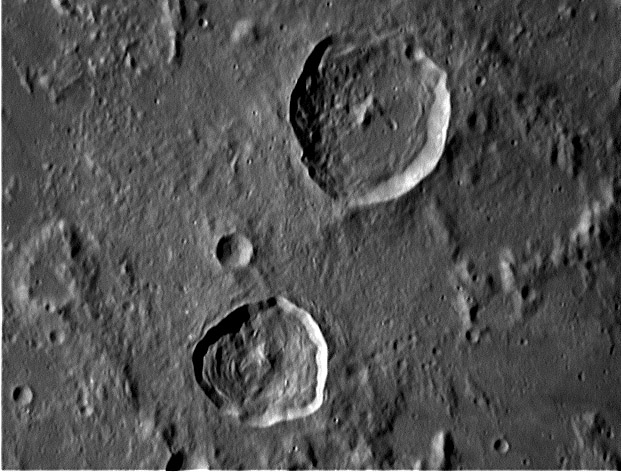
image by Wes Higgins
One month ago today LPOD came back to life with a wonderful image from Wes Higgins. Here is another one to mark the occasion and provoke thinking about landslides. Agrippa (above) and Godin are rarely imaged craters in plain view near the lunar center of face. They are probably overlooked because of their location near the triumvirate of rilles: Ariadaeus, Hyginus and Triesnecker. But Wes noticed them and captured an excellent relatively high sun view that exposes their interiors. With diameters of 46 and 35 km these are complex craters with central peaks and rim terraces. Agrippa has a bit of flat floor, and on the east side there is a arucate mound of relatively smooth material that has rolled down the crater wall. The west wall and floor are more rugged and less coherent. It looks like a lot of material still clings to the wall and what has slipped to the floor was piecemeal. Godin has no floor, its entire interior is covered with material that slid down the walls and piled up as wide and high terraces. On the east side there is little apparent structure in the slumped mass, but distinct curves define terraces on the western side and you can imagine how rim material cascaded downslope in orderly masses. Landslides occur when complex craters are formed as part of the accommodation to the removal of rock from the crater center. But I also think landslides and jumbling reoccur whenever later impacts create moonquakes. Older terraces are usually structureless from such repeated shaking – this implies that Agrippa is older than Godin. In any case, at both Agrippa and Godin the landslides created steeply sloping walls – it would be hard to drive or hike into these craters.
Technical Details:
June 26, 2005. 18″ Starmaster Reflector, Infinity 2-1M camera, MAP processing, 20fps.
Related Links:
Rükl chart 34
Wes’ lunar photos
Yesterday's LPOD: Gaussian Blur
Tomorrow's LPOD: Kepler Ahead
COMMENTS?
Register, Log in, and join in the comments.



